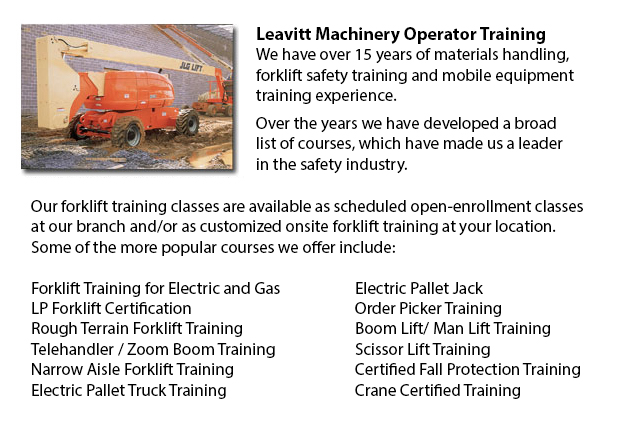
St Catharines Boom Lift License - Only completely qualified individuals should operate an aerial boom lift. Qualification can be obtained through a combination of sessions in the classroom and practical training with the specific type of aerial lift that will be used on the job. A License is required for anyone who works on or operates an aerial boom lift.
Vehicle-mounted aerial devices comprise the following work vehicles: aerial ladders, extensible boom platforms, articulating boom platforms, vertical towers, and whatever combination of these kinds.
There are a number of basic safety regulations which apply to all boom lifts. Worker safety while in the basket is a top priority. Workers should put on a body harness and lanyard connected to the boom or basket. Never tie off to a structure, equipment or an adjacent pole. Personnel must stand on the basket floor, and never sit or climb on the basket edge. The manufacturer's load limitations should be adhered to.
Aerial lift operators should be authorized to make use of the equipment. The operator has to be familiar with all the aspects of the device and must have access to the manufacturers manual that must be kept within the lift. Operators are responsible for ensuring that safety procedures are followed in operating the lift. Testing lift controls on a daily basis must be performed. Position outriggers and set brakes (if they are used) on a stable surface or on pads. When working on a slope, make use of wheel chocks.
Never move an aerial lift truck with an elevated boom while workers are in the basket. Articulating boom and extensible boom platforms used as employees carriers should have accessible, plainly marked, upper controls. Except for in emergency conditions, lower controls should not be utilized to override upper controls unless permission has been given by the person within the lift.
While working from an aerial lift, do not wear pole or tree climbers.
Do not alter the insulated portion of the aerial lift.
Make sure that the booms are thoroughly checked, that the machinery is correctly cradled and the outriggers are in the stowed position before moving.
Make certain that lifts being utilized in or near power lines are di-electrically tested and follow local rules.
-
St Catharines Heavy Equipment Training Schools
St Catharines Heavy Equipment Training Schools - When selecting an operator training course, there are a lot of heavy equipment training schools to choose from. To be able to ascertain the qualifications you will attain, it is very important to explo... More -
St Catharines Heavy Equipment Operator Training
St Catharines Heavy Equipment Operator Training - Heavy equipment operator training facilities that offer quality standards within the business, offering field performance work and additional machine training are really sought after training features... More -
St Catharines Forklift Training Programs
St Catharines Forklift Training Programs - Are you looking for work as a driver of a forklift? Our regulatory-compliant mobile equipment operator training offers instruction in kinds of forklifts, pre-shift check, fuel kinds and handling of fuels, an... More -
St Catharines Heavy Equipment License
St Catharines Heavy Equipment License - A heavy equipment license can be obtained by taking a certification and preparation course at a private training school or a vocational school. This license would qualify you to operate various types of heavy e... More -
St Catharines Overhead Crane Safety Training
St Catharines Overhead Crane Safety Training - Overhead crane safety training equips operators with skills and knowledge regarding crane safety precautions, accident avoidance, materials handling, and equipment and stock protection. Trainees will lea... More -
St Catharines Scissor Lift Training
St Catharines Scissor Lift Training - Scissor lifts should be operated proficiently to be able to protect the safety of the equipment and the wellbeing of others within the workplace. Operators who are skilled are trained to drive the specific type o... More -
St Catharines Telescopic Training
St Catharines Telescopic Training - Telescopic Handlers are a kind of forklift, normally known as telehandlers. This machine has been increasing in popularity due to its greater lift heights and its versatility. It is often preferred over the convent... More -
St Catharines Boom Lift Certification
St Catharines Boom Lift Certification - Utilizing elevated work platforms allow for maintenance operations and work to be carried out at elevated work heights which were otherwise unreachable. Boom Lift Certification Training educates workers about t... More

Forklift Certification St Catharines
TOLL FREE: 1-888-254-6157
St Catharines, Ontario
forkliftcertificationstcatharines.com/
Email Us
About Us


